In an unlikely location, Hyke Farms provides food and a buffer against catastrophe through backyard farming.
By the time you’re 30 minutes east of Los Angeles on the 210 Freeway, you have no sense whatsoever that you’re in farmland. After all, you’re on the freeway, in the heart of urban sprawl. If you exit the freeway and head north into the quaint suburb of Duarte, you still don’t feel like you’re in farmland.
“’I don’t call it a “garden” … because gardens are for amateurs who want a distraction from their daily routines. What we’ve got going here is serious business.’”
As you drive closer to the towering foothills of the Angeles National Forest and turn down a typical street, you finally approach the Hyke residence … but this one has no front lawn; just lots of native plants. Even so, there’s still no indication you’re entering a little farming operation.
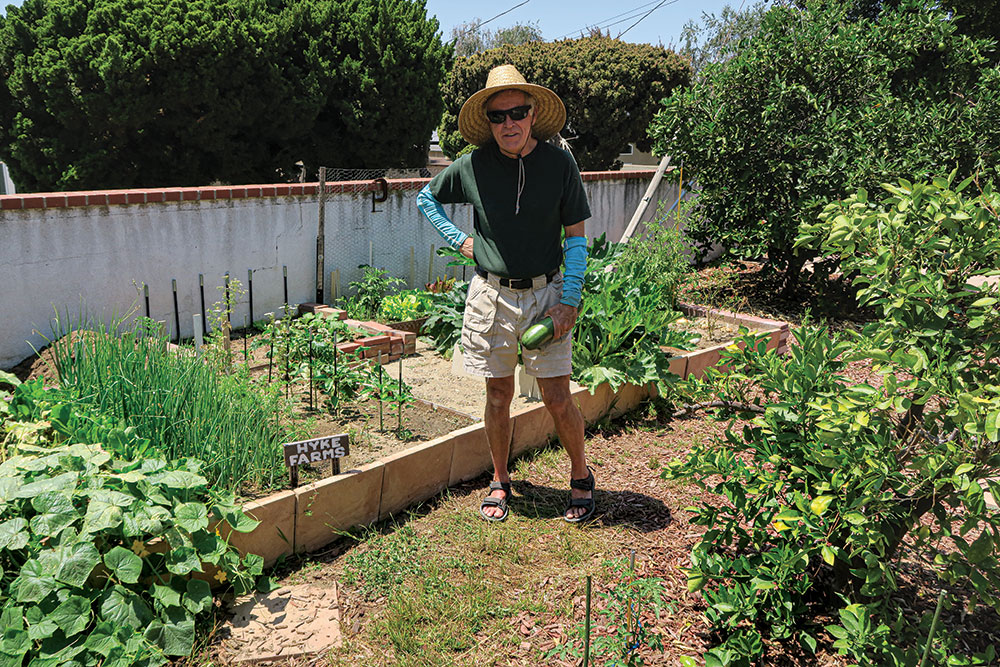
“Welcome to Hyke Farms,” shouted a smiling Daniel Hyke as he welcomed me to a short tour of his backyard farming operations. “Hyke Farms might well be the tiniest farm in America.”
“I don’t call it a ‘garden,’” Hyke explained, “because gardens are for amateurs who want a distraction from their daily routines. What we’ve got going here is serious business. In fact, I’d had this micro-farm going for more than 20 years, mostly growing just tomatoes.”
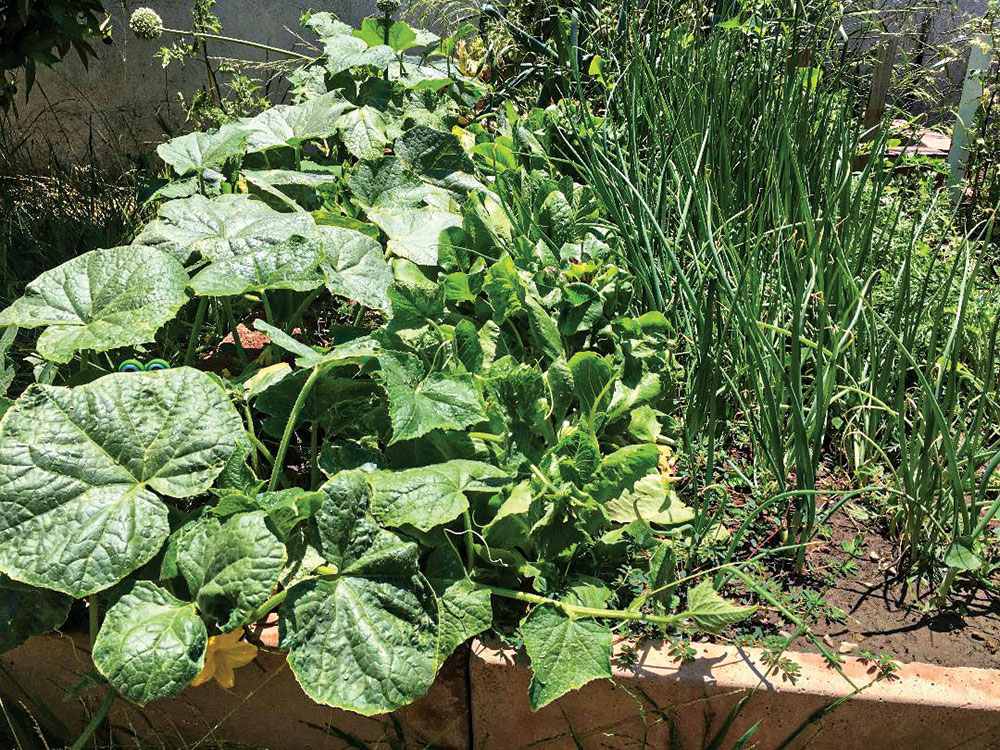
Then, on a fluke, Hyke decided to plant a winter garden for the first time—something that can be done in Southern California because of its mild winters.
“I planted four varieties of lettuce, spinach, cilantro, radishes, broccoli, turnips, carrots and peas and kept a couple of bushes of cherry tomatoes going,” he said, pointing to the raised beds. “It was a real experiment.”
He started the winter garden in mid-November 2019. Three months later, the worst pandemic in more than 100 years hit.
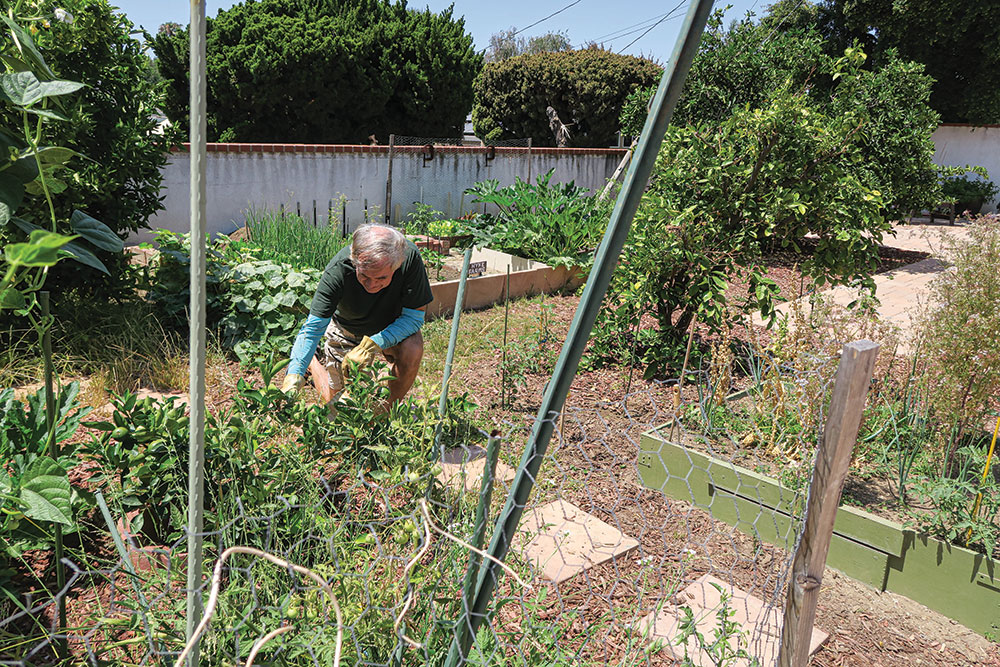
“Suddenly, my wife Thuy (pronounced “Too-we”) and I were afraid to leave the house. We weren’t about to head out to the local supermarket,” he explained. “Luckily, a year before, we’d stockpiled a 50-pound bag of rice and two 30-pound bags of pinto beans in the garage.
“That first winter garden had been a huge success and was already producing ingredients for a large salad every night for the two of us. I couldn’t believe my luck—planting it just 14 weeks before COVID hit.”
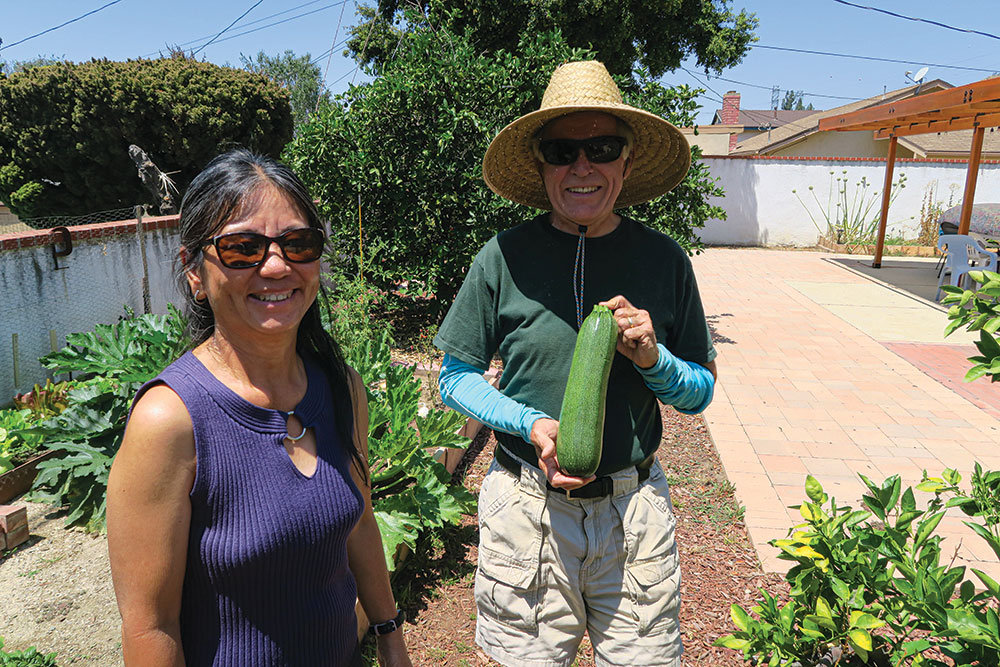
When the Hykes began their backyard farming, they only had four small plots. The farming operation has since expanded to 13 plots that range in size from 1 to 3 square meters. Now, they have 23 square meters under cultivation, not including four fruit trees and two herb pots. That’s 250 square feet, or a square 16 feet per side. According to Hyke, that’s the tiniest farm in America.
“Hyke estimates that his little farm produces about 25 to 30 percent of all the food they eat, depending on the season.”
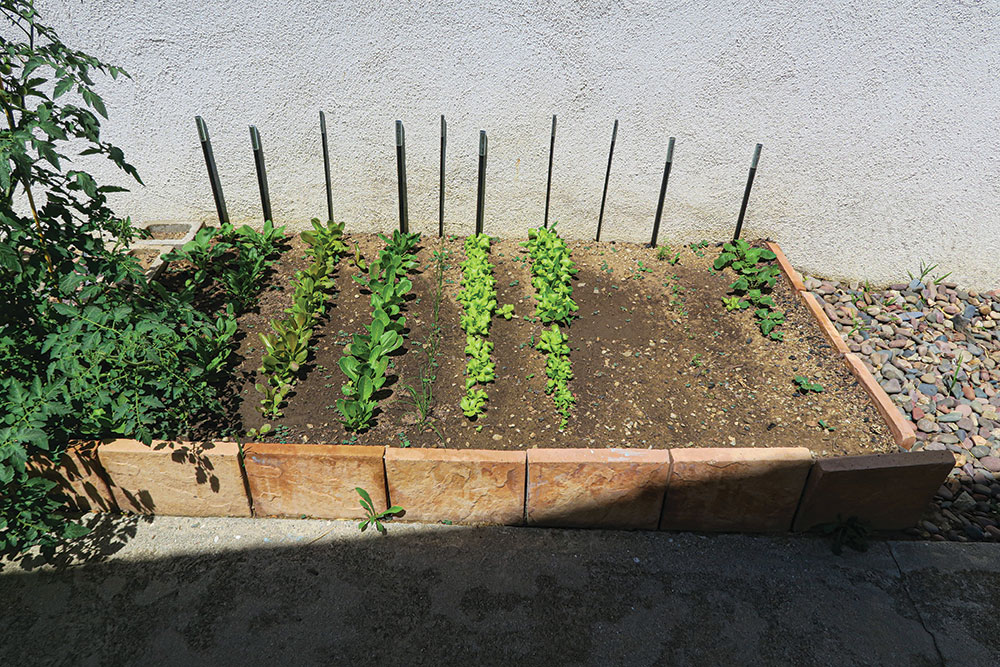
“I use high-intensity farming, which means I plant my crops much closer together than most professionals recommend. I get away with it because of my soil. Soil is everything when it comes to growing food. Per square foot, I probably have the most productive farmland in the country.”
SOIL ‘FORMULA’
Hyke describes his “formula” for soil as follows: 40 percent ordinary soil, 40 percent organic compost and 20 percent worm castings, rabbit droppings, fire ash and a few handfuls of store-bought organic fertilizer. He begins working each mini-section by screening the ordinary soil to remove all the gravel and small rocks.
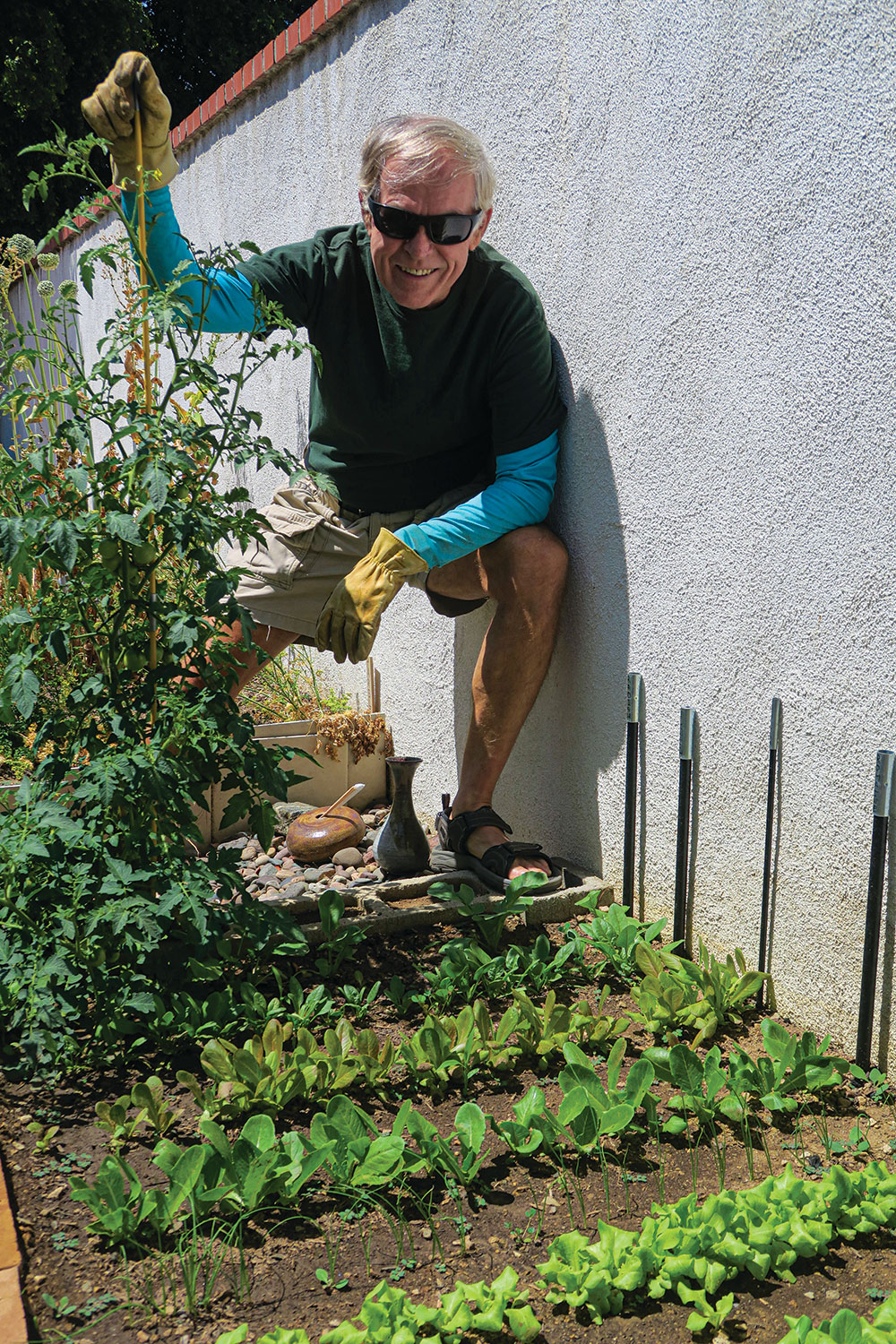
“Only microscopic mineral particles hold plant nutrients such as potassium, magnesium and nitrates,” he said. “Gravel and rocks are useless and only get in the way of root development.”
He saves the sifted gravel for drainage purposes around the yard, and the larger rocks are used for landscaping. Hyke estimates that he and his wife could survive at their home for at least a year without going to the market.
“As long as we have water, we’re good,” Hyke pointed out.
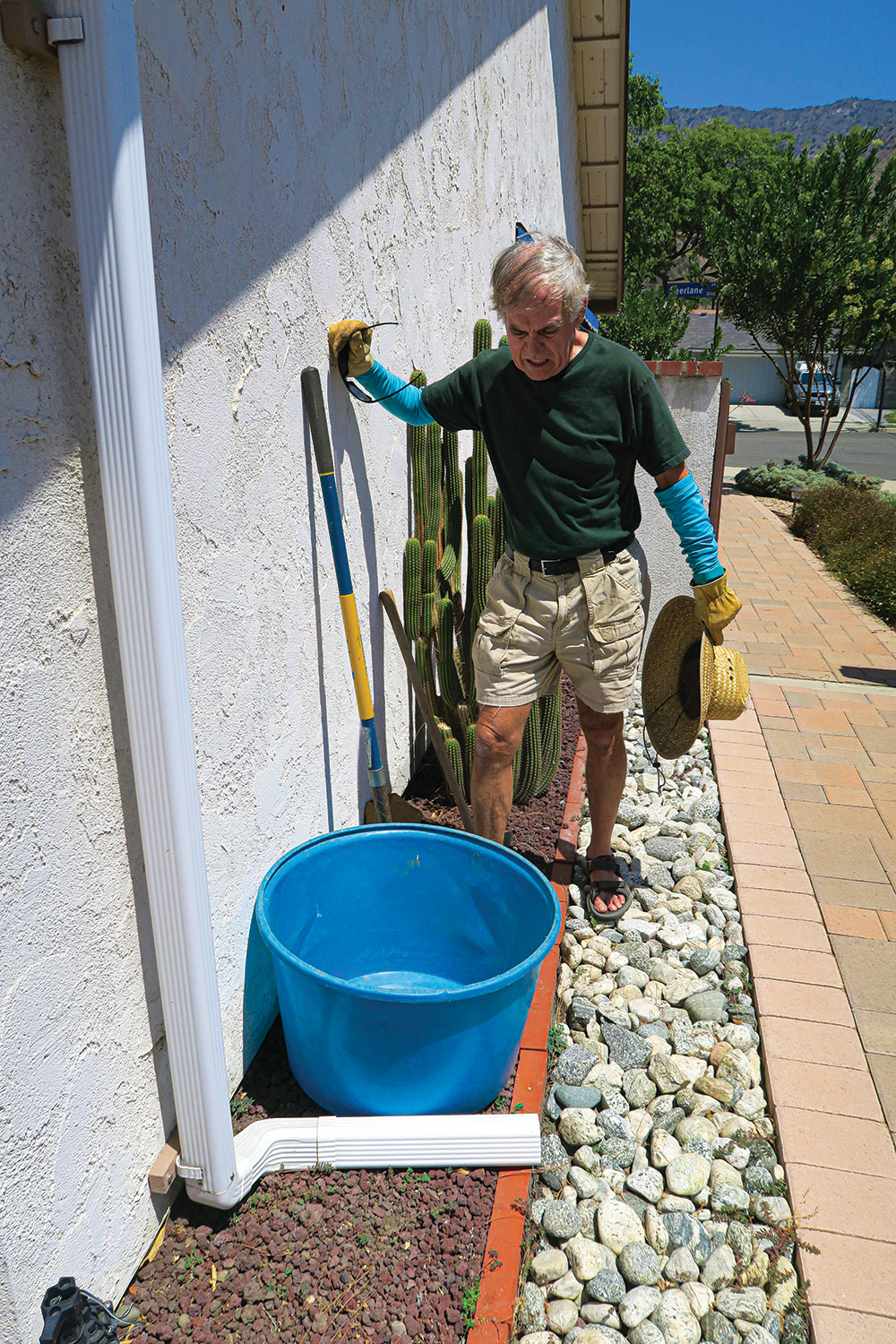
Because of the rice, beans and the micro-farm, itself, along with four fruit trees, a pot of spearmint, a pot of basil and a neighbor’s avocado tree, they’re on solid culinary ground.
“We’re living like kings!” he said. “We’re eating better than ever. I’m not kidding. We’re talking about huge, beautiful salads that you just can’t buy in a restaurant.”
Hyke began his gardening career when he was in 4th grade in Dallas, Texas.
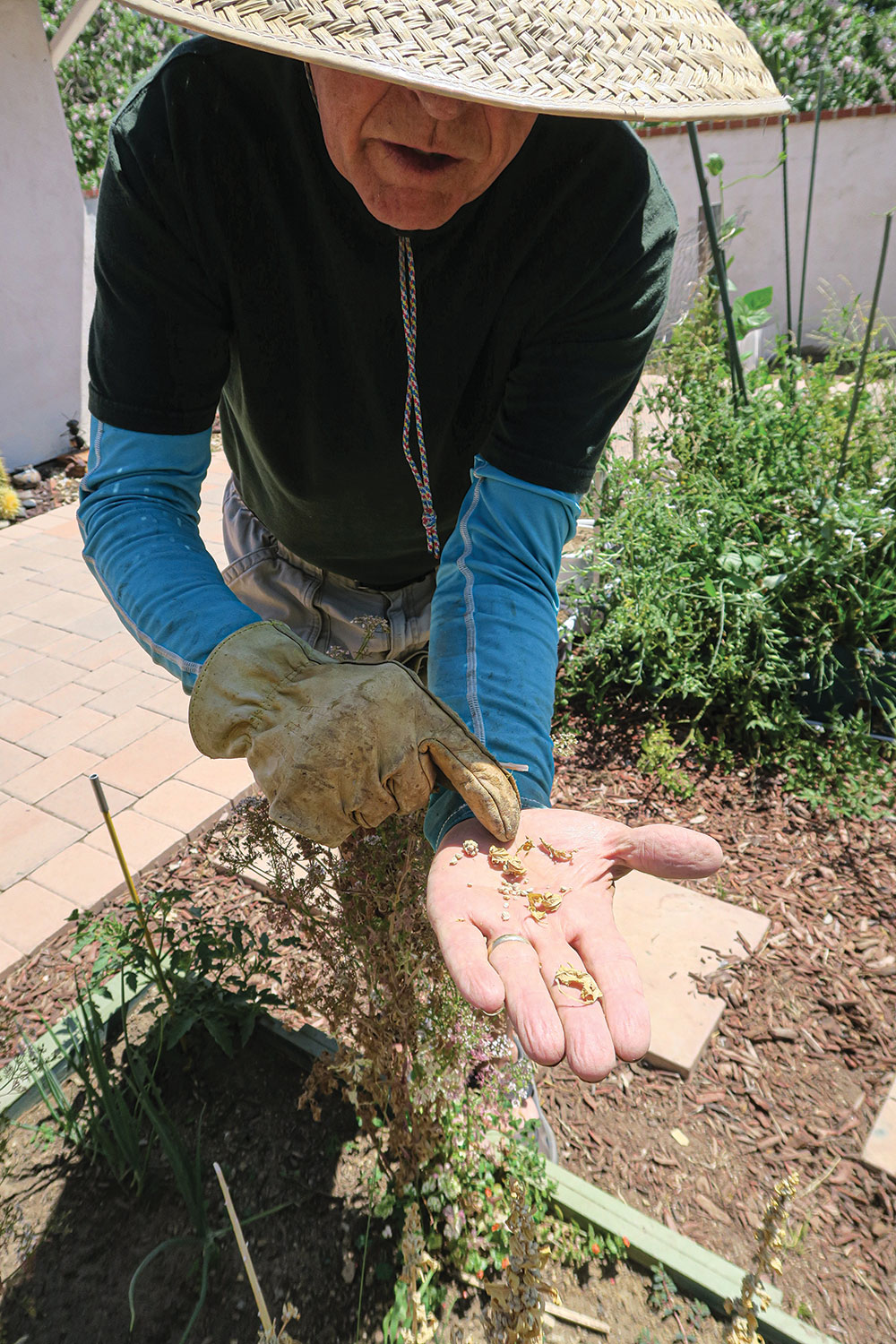
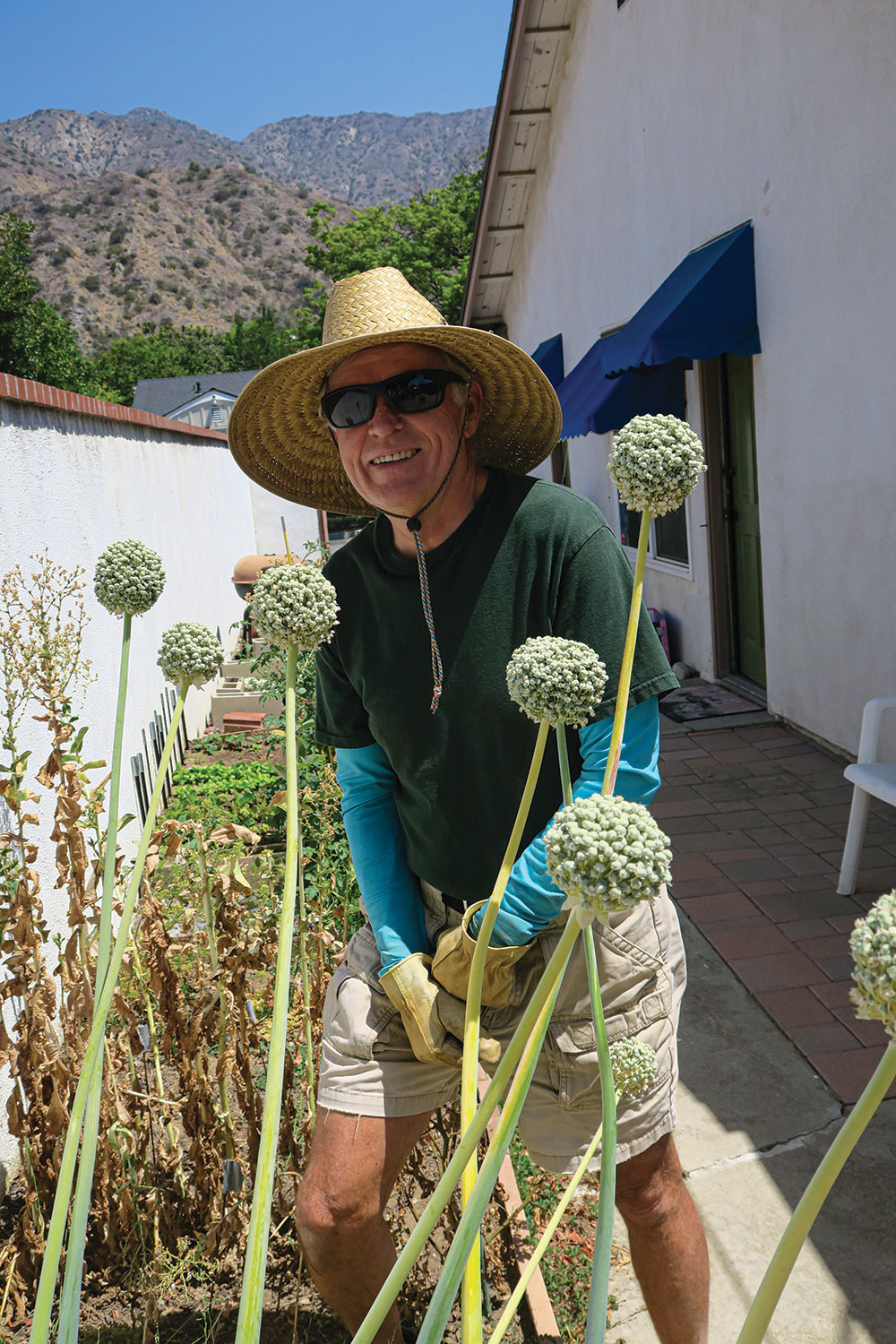
“My father let me plow up half the backyard. I was only 10 years old, and I was growing corn, cantaloupe, beans—everything! I loved it: buying the seeds and looking at the little maps on the back. Plowing the soil and getting dirty. Watering. Watching the baby seedlings pop up. Harvesting the food that I’d grown and watching my family eat it,” he fondly recalled.
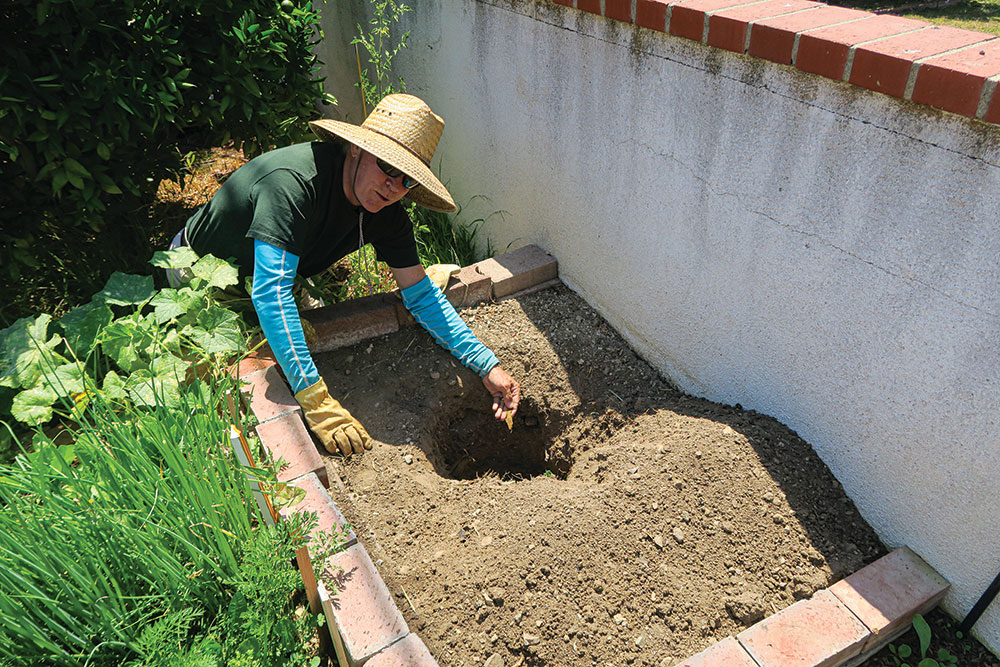
His family moved from Dallas to Eagle Rock, California, in 1964 and then to Altadena in 1965. He and Thuy moved from Pasadena to their nearby Duarte home in 1995.
COMBATING PESTS
Pesticides are not allowed or used on Hyke Farms. Hyke only uses biological controls to stop pestilence. Lizards, multiple species of insect-eating birds, ravenous ladybugs and hardworking spiders all keep down the population of undesirable bugs and insects. He believes that 99 percent of his crops remains undamaged at harvest time.
“Over the past few weeks, I’ve noticed a couple of medium-sized rats hanging around. I’ll be picking up one of those cage traps and relocating the rats to the mountains. I have a lot of trouble killing things, even pests. I’m a bit of a ‘softie’ when it comes to living creatures. I like to encourage life, not death. Heck, I even have difficulty thinning my radishes!”
THE PROCESS
Every garden plot starts as a 3- to 4-foot-deep pit. Soil is removed, screened and used elsewhere. Then, the pit begins as a compost pit, into which all nonedible green waste, including kitchen waste, is added. Hyke concedes that his below-ground-level pits take a bit longer for the green waste to decompose because of the lack of air (oxygen) and possibly reduced moisture level.
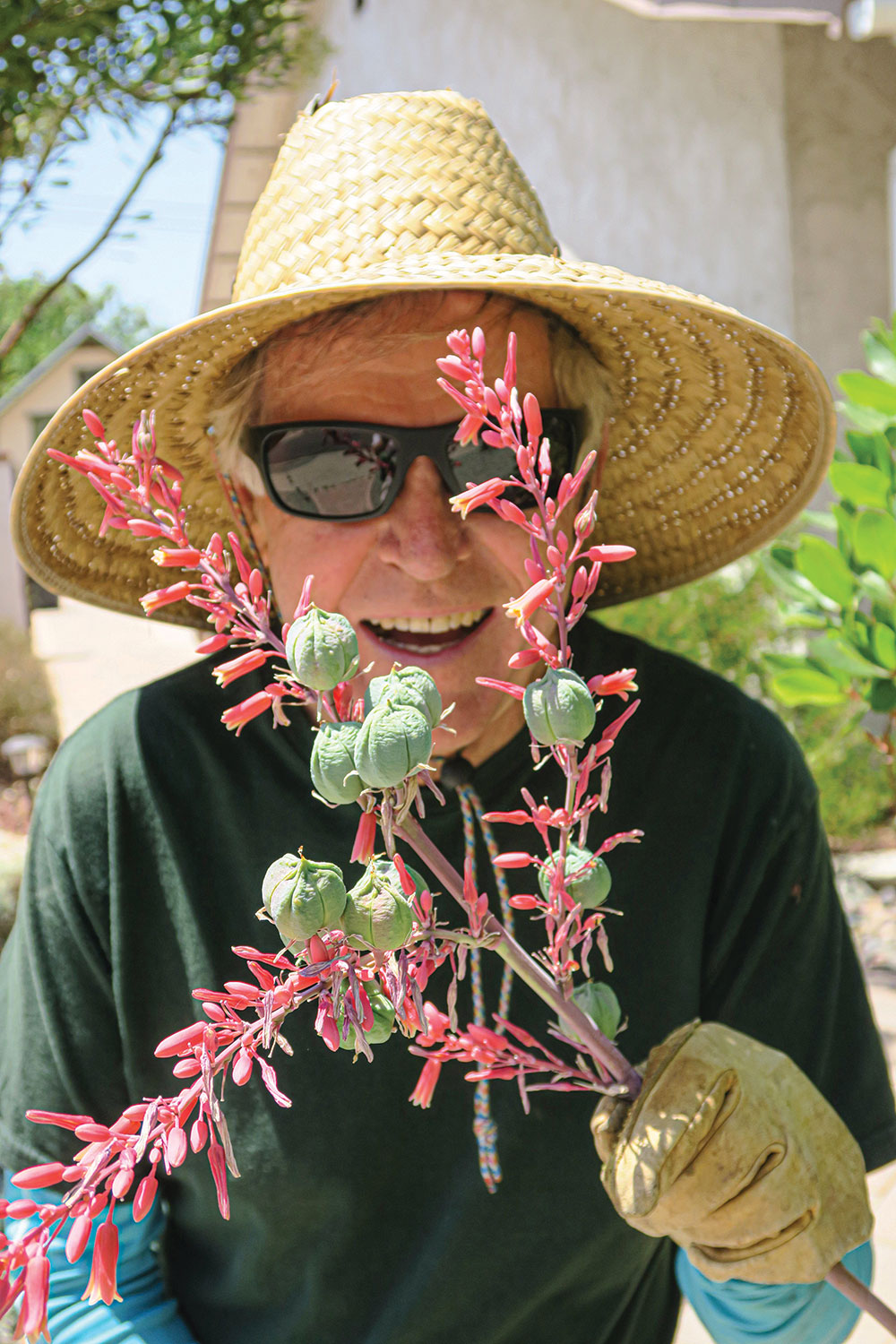
“When the pits are nearly full, I cover them with 6 to 8 inches of my soil mixture, and they become another productive farm plot,” Hyke explained. “Aboveground compost bins are a big hassle and a huge amount of work. I don’t have the time or patience for it.”
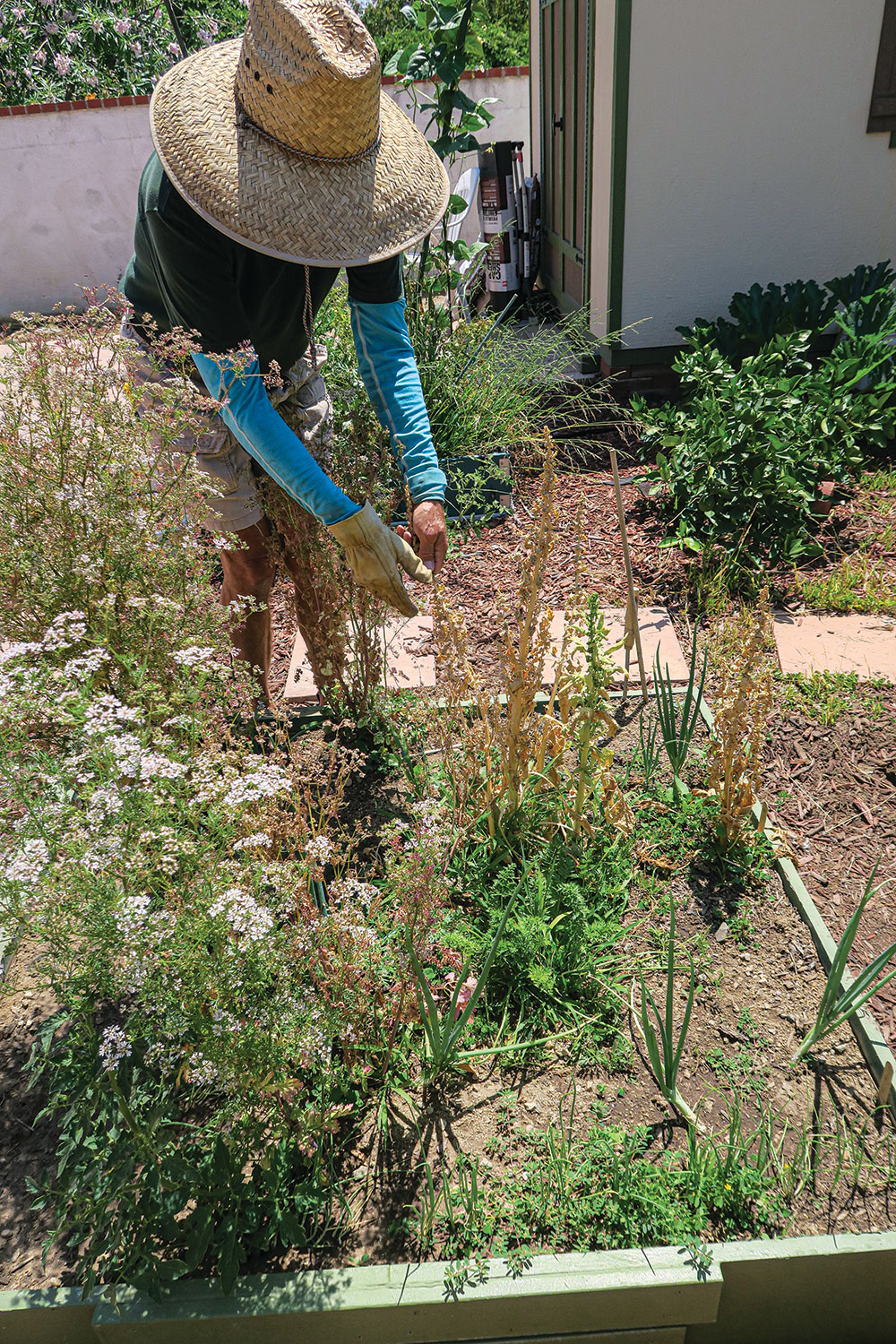
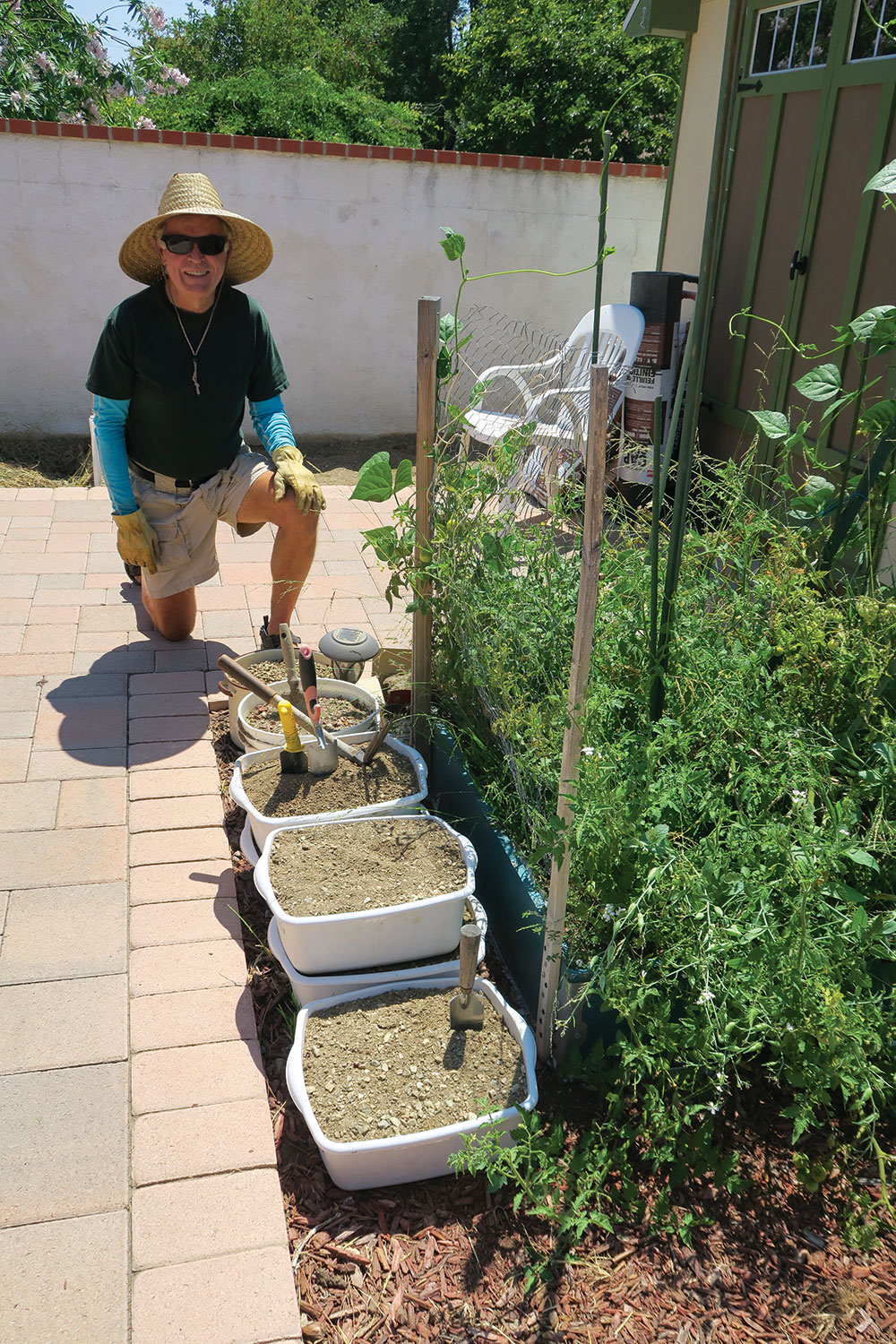
Once operational, the pits provide a long-term source of nutrient-rich compost that can be used for years into the future.
Hyke’s biggest problem is weeds. And, as you might have guessed, he uses no herbicides on his backyard farming land.
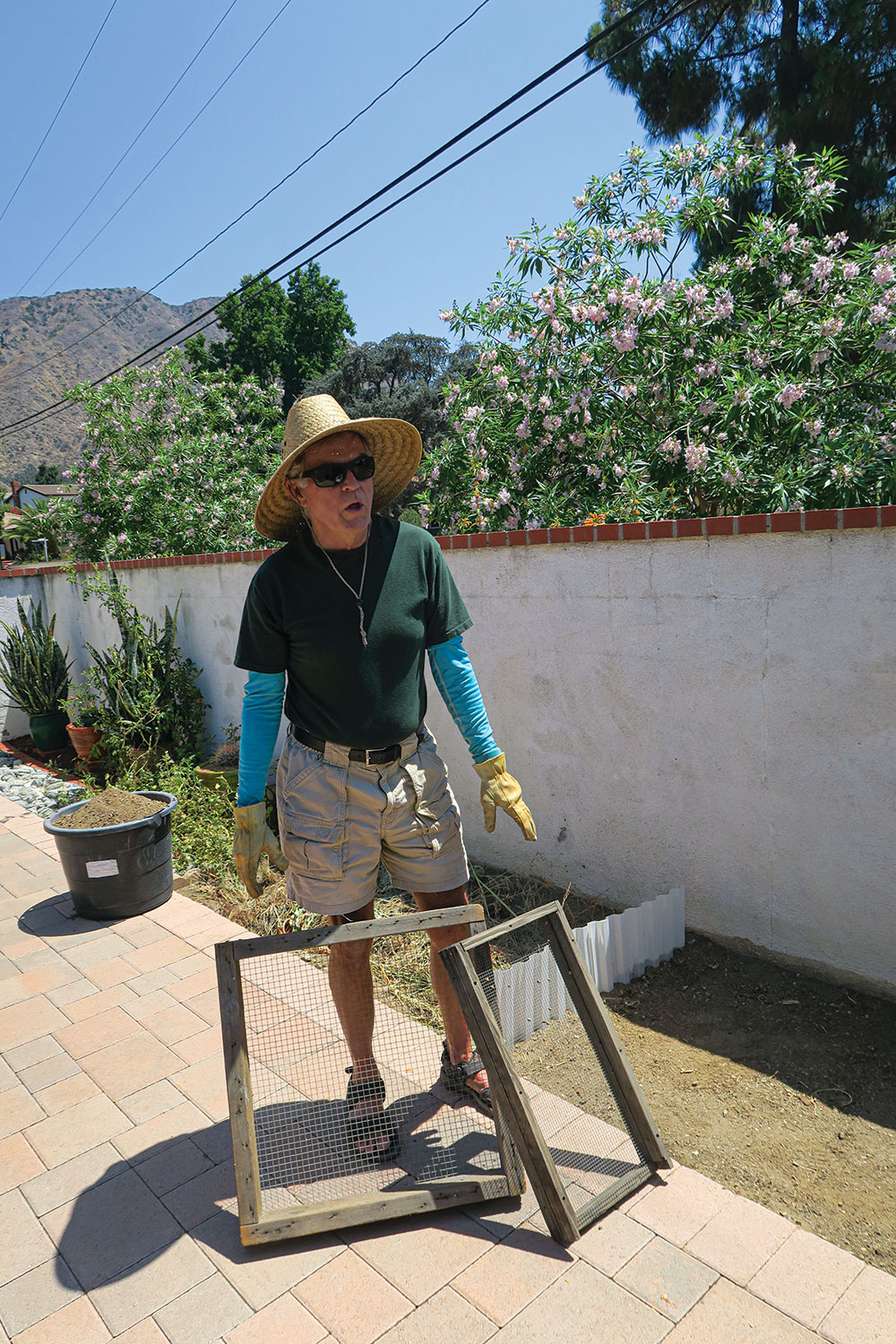
“Weeds drive me crazy,” he said. “They grow twice as fast as vegetables. Their roots are tenacious. I just hate them. But it’s a lot easier to get them out of raised beds, as compared to regular dirt, because the soil mixture is so soft. I pull them out while they’re young and turn them into instant mulch for my veggies.”
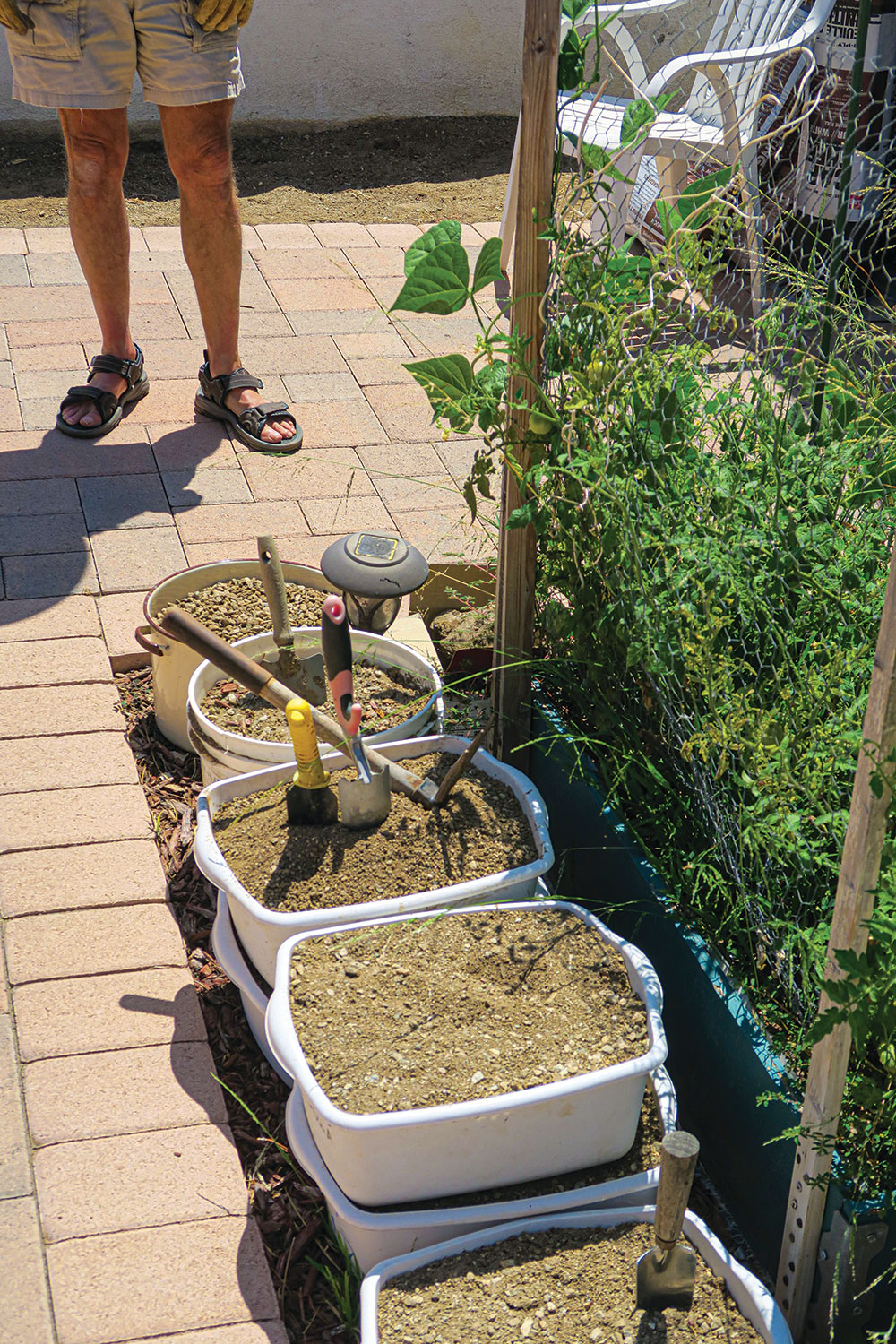
The walls of his raised plots are built with bricks, masonry paving stones and concrete construction blocks. Over the years, Hyke has found that untreated wood, even when it’s painted, tends to rot quickly; usually within two or three years.
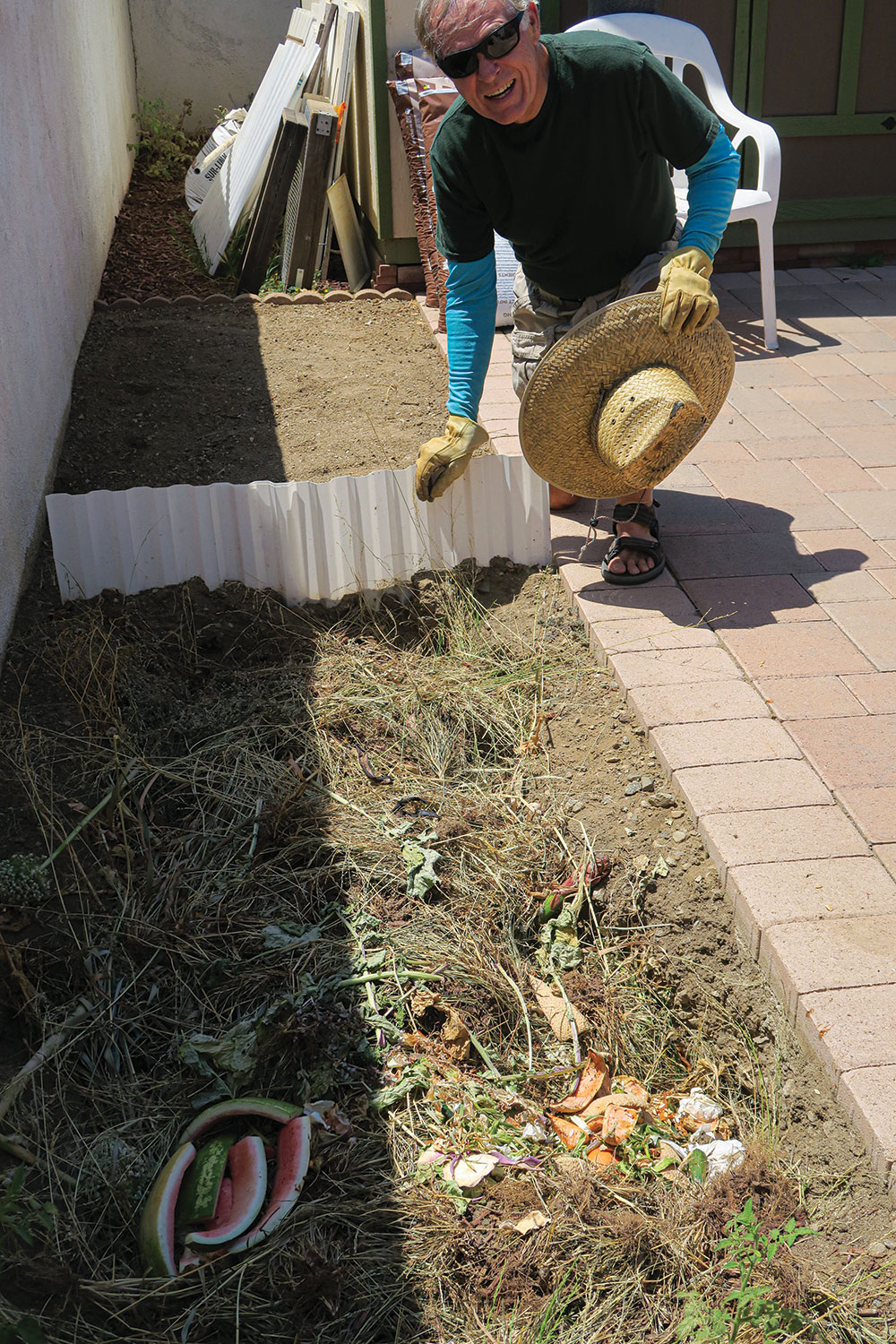
Plastic walls deteriorate because of ultraviolet radiation from the sun and produce microscopic pieces of plastic, which are damaging to the environment. Although he currently uses mostly bricks and paving stones for the walls of his plots, Hyke regards galvanized steel containers and creosote-treated wood as acceptable alternatives to masonry products.
THINK GLOBALLY
Hyke is a retired school teacher who likes to think globally. He pointed out the environmental benefits of his operation:
“When I want to make a salad, the food moves a few feet to my kitchen—not hundreds or thousands of miles across states or continents. Just think about the reduction of CO2 emissions: It’s huge! I am not relying on manufactured inorganic fertilizers or pesticides and all the mining, energy and fossil fuels it takes to produce them.
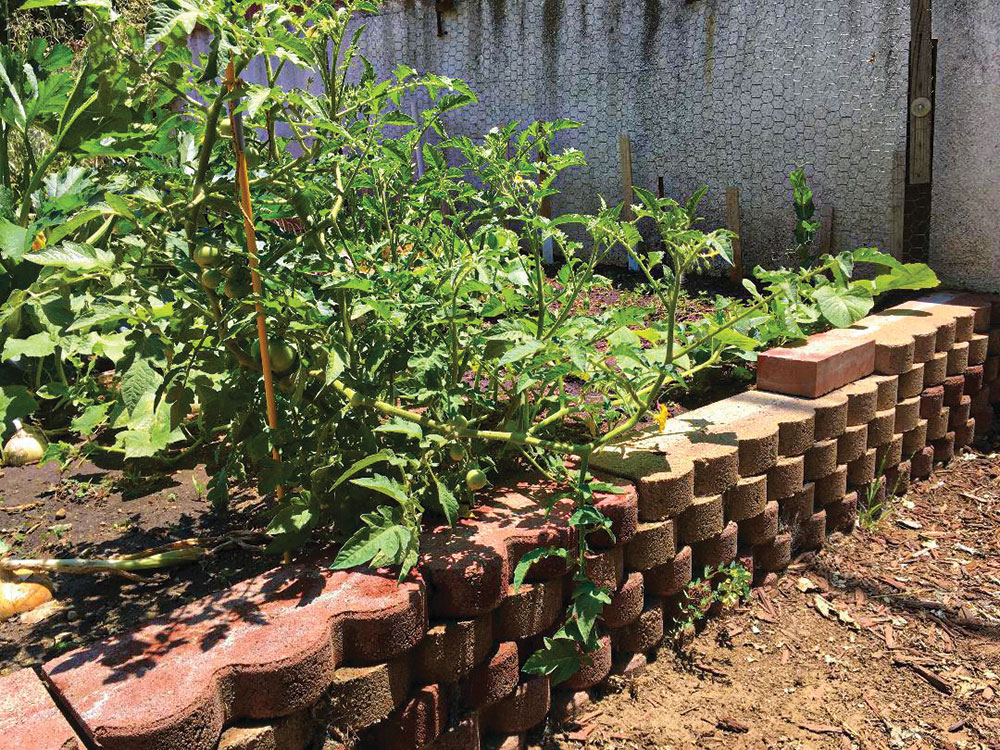
“And don’t even get me started on water! Because each small, high-density plot can be flooded, I’m not watering soil without roots in it. Every drop goes to use. And because these plants are close together, they shade each other and prevent evaporative loss. During the winter, I capture rainwater off my roof in large barrels.”
BARTER, SHARE
All the green waste from the Hyke mini-farm is recycled on-site and, therefore, it doesn’t end up in a landfill or at a municipal composting facility that requires the heavy use of fossil fuels.
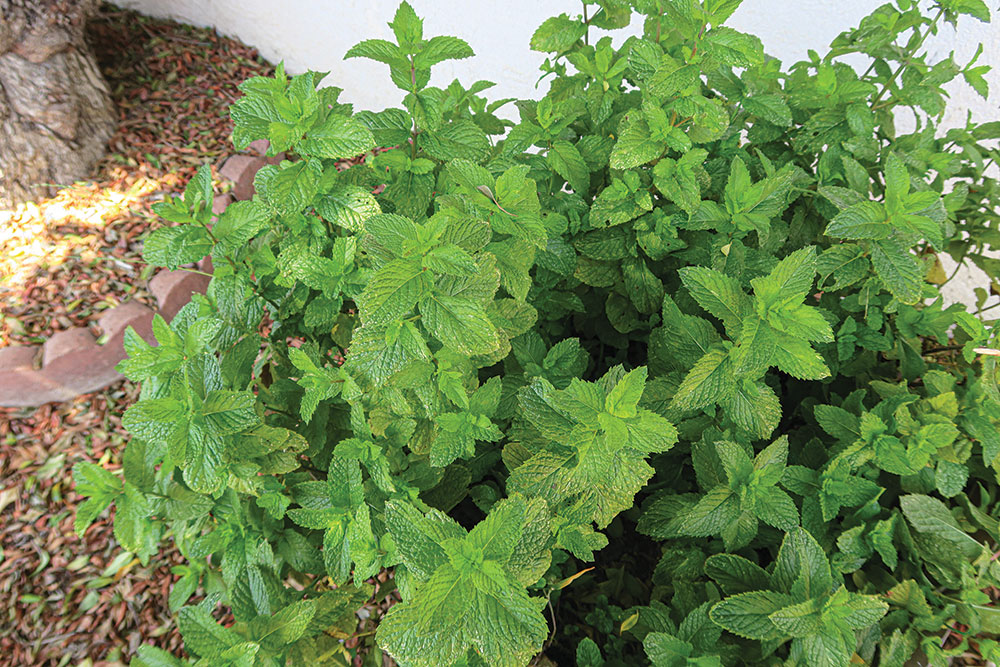
Once he’d gotten his farming operation well established, Hyke pointed out that it now requires a lot less work and effort than he expected. He spends about 50 minutes each week hand-watering his plants. One hour a week is spent weeding and two hours digging new compost pits and preparing newly cleared plots for planting. He gardens rigorously and considers it a form of exercise, along with the hiking, biking, swimming and occasional yoga sessions.
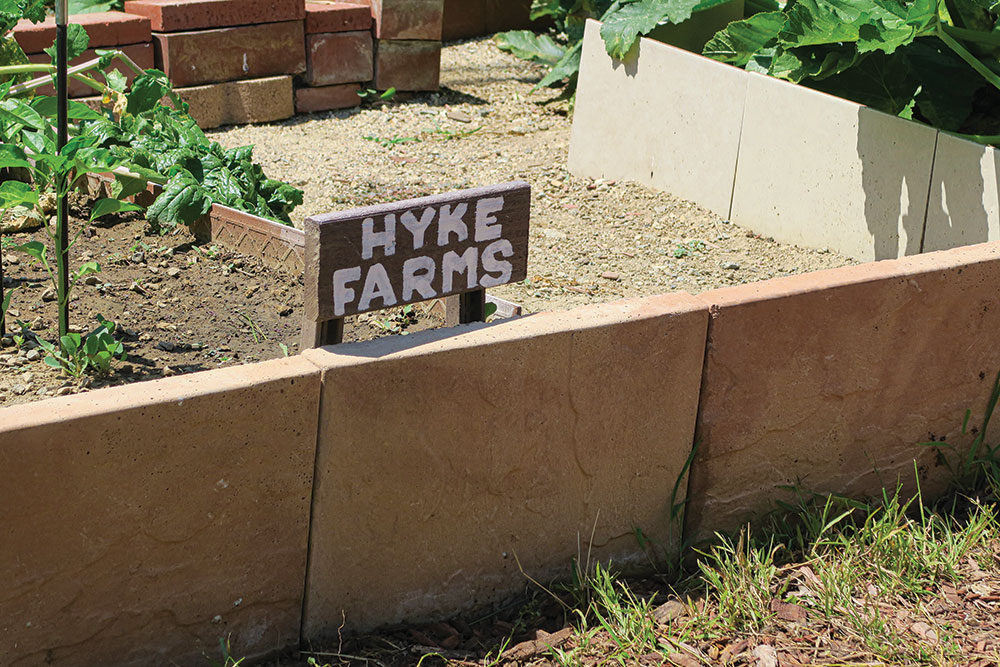
The whole neighborhood benefits from Hyke Farms. Thuy Hyke loves to give away food to the neighbors. Onions and cilantro go to their Middle Eastern neighbors down the street. Lettuce and tomatoes end up at her sister’s house, and giant zucchini squash are delivered to their good friends.
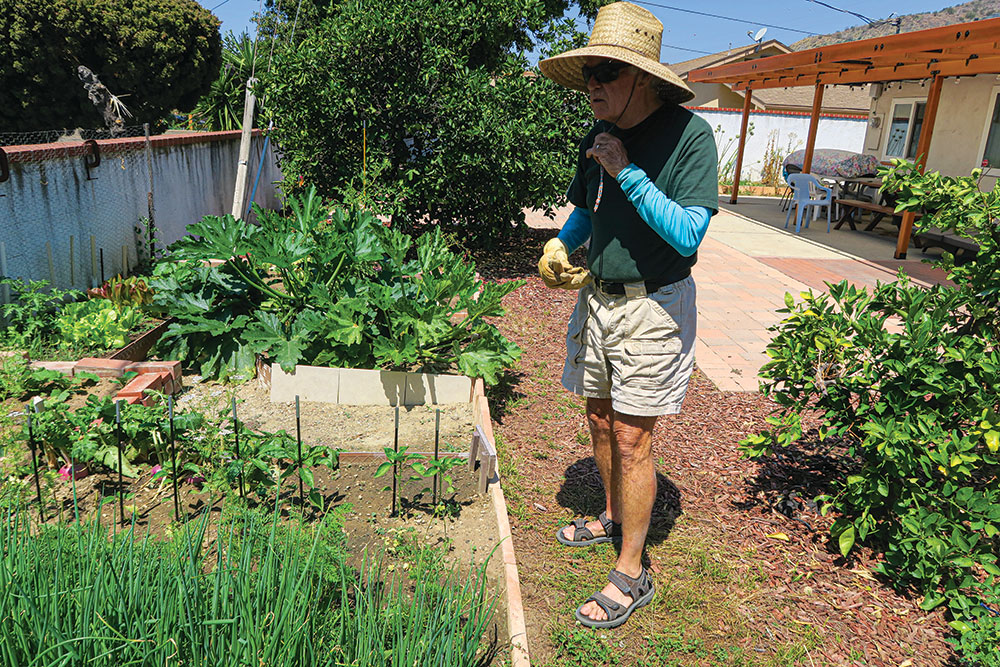
According to Thuy, sharing the abundance helps bring the community together. During the recent pandemic, Daniel found that their efforts at sharing food was helpful in maintaining everyone’s mental and physical health.
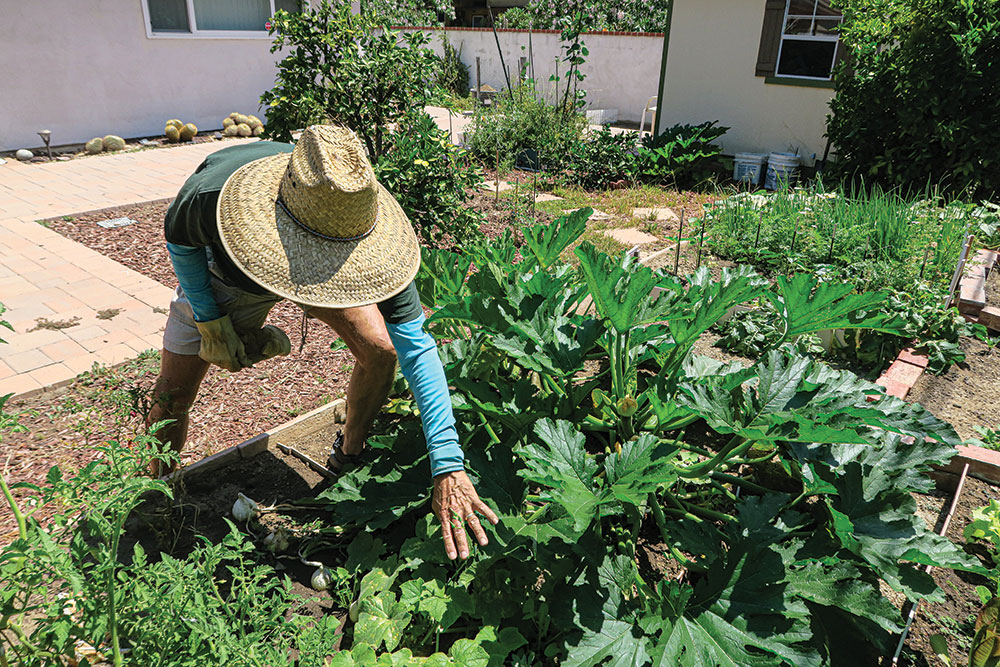
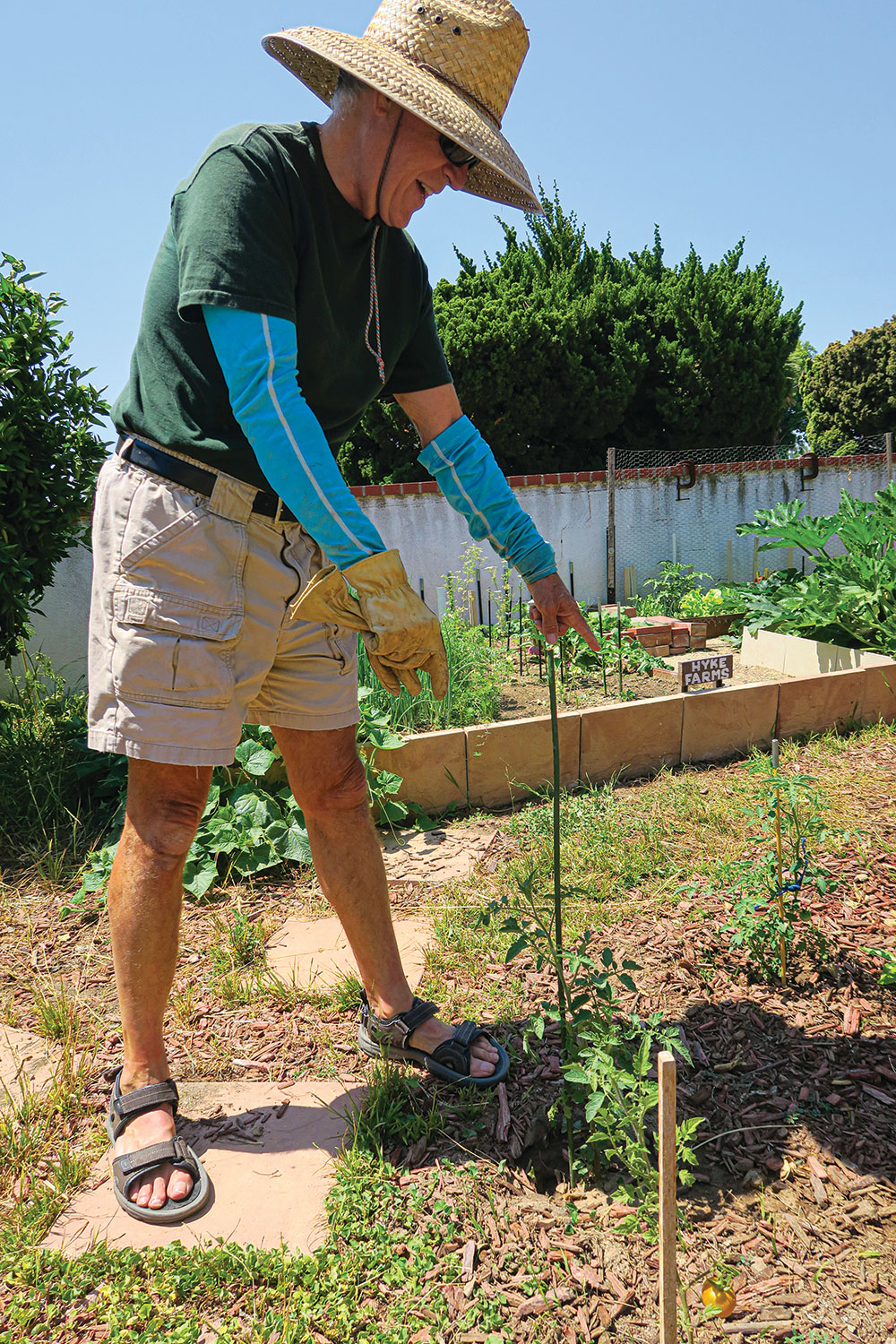
“We never made a penny from the farm, but we did a ton of bartering,” he said. “You can get a one-hour swim in a private pool for two zukes and five tomatoes. A bag of tangerines gets your faucet fixed. And, if you’re out backpacking the Pacific Crest Trail for 10 days, you can get your garden watered in exchange for unlimited access to the farm’s produce. What a deal!”
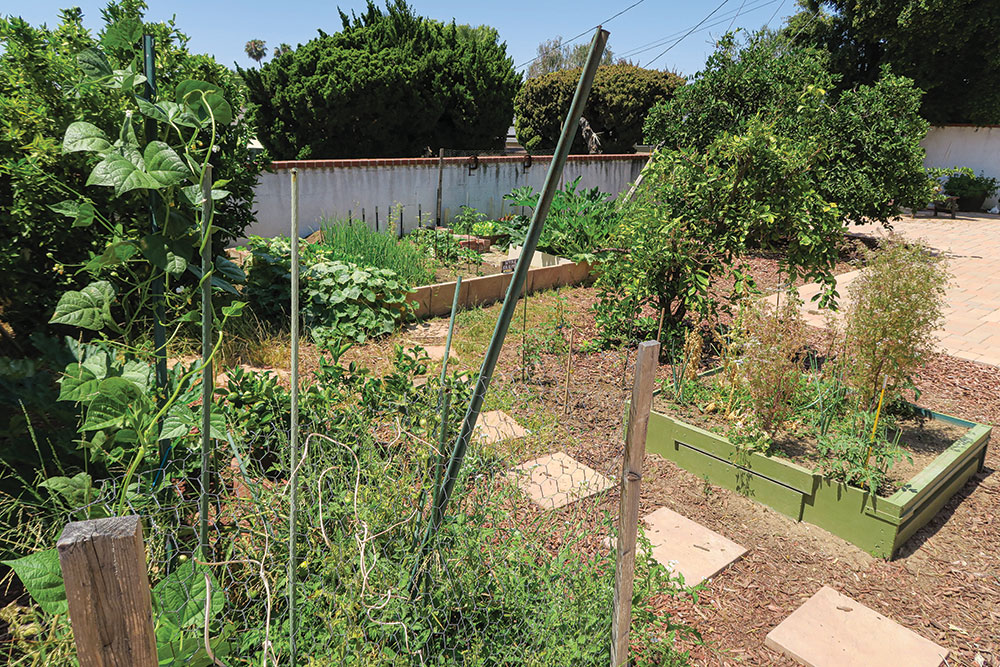
Other than the lizards, birds, bugs (and a couple of unwanted rats), there are no animals on the farm—no chickens (although they’re legal in Duarte) and no rabbits (Hyke gets rabbit droppings for his soil from friends). And, no, the Hykes are not vegan.
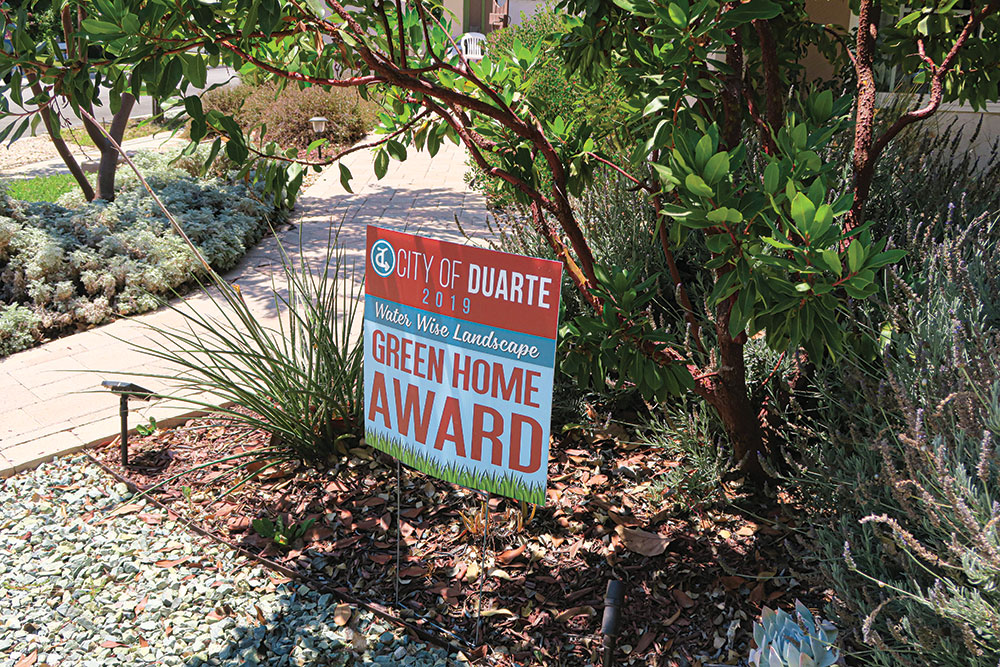
“I’m just too lazy to bother with animals,” he said. “They’re a lot of work, eat valuable crops and can cause damage to the plants.”
Hyke estimates that his little farm produces about 25 to 30 percent of all the food they eat, depending on the season.
“’I’m very proud of my little farm … It’s the American way; you know—self-reliance.”
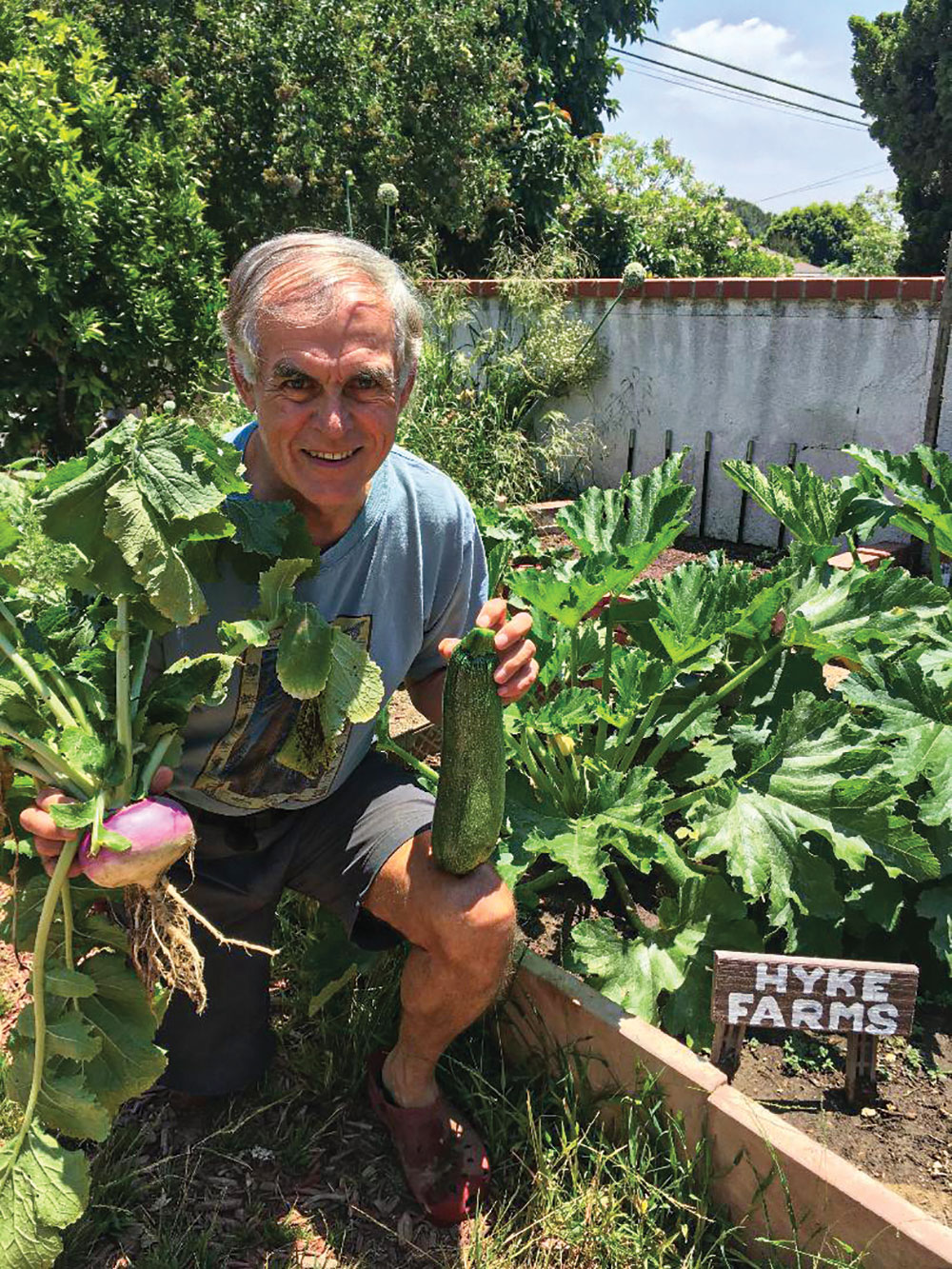
“I’m very proud of my little farm,” he said. “It’s the American way; you know—self-reliance. I make sure my soil never dries out, especially when I’m germinating new seeds. And I always try to keep my soil covered with some kind of mulch, such as compost or leaves. By improving the quality of the soil, we can grow a lot more food in a smaller space.”
MORE QUESTIONS FOR DANIEL HYKE
AOG: Does your winter water cache last the year? If not, where does the rest of the water come from?
Hyke: My winter water cache, which entails several buckets and tubs of water collected from my roof, will last through May and possibly into June, depending on how hot and dry things become. After that, I rely on city water from my faucet in the backyard. I could install large cisterns and make it further into the summer, but I haven’t done that yet.
AOG: Where do you get your seeds?
Hyke: Almost all my seeds are harvested from the previous season’s crops. I let some of my biggest and best plants go to seed every year. This includes radishes, five varieties of lettuce, spinach, cilantro, turnips, carrots, onions, cucumbers, zucchini and parsley. Tomatoes are a special case. So many drop off the tomato plants and get mixed into the soil that I have numerous “volunteer” plants coming up every year, so I don’t even have to think about collecting tomato seeds. If I want to try something new, I’ll go to the nursery and buy a packet of seeds. But I keep a large supply of seeds stockpiled (and dated) for any emergency scenarios that might come up.
AOG: Do you rotate crops between plots?
Hyke: Like every farmer, I rotate my crop among 13 different growing plots. Every plant uses slightly different nutrients, and by rotating the various vegetables, the soil will last longer. I use organic fertilizers, fire ash, compost and virgin (screened) mineral soil excavated from holes that will become new compost pits. When it’s not under cultivation, the soil is covered with leaf mulch to reduce water loss and maintain the viability of essential soil microorganisms.
AOG: What preservation methods do you use to keep food stored long-term?
Hyke: Generally, I don’t need to preserve much of the food I grow, because my garden produces year-round here, in Southern California. The key for me is to plant at regular intervals and grow just what we need. Sometimes, we dry fruit, such as apricots, to preserve them long-term.
AOG: How do you build your compost pits?
Hyke: I dig my 3×5-foot, below-ground-level compost pits with a pickax and shovel. It’s a bit strenuous, especially with the rocky soil we have. I regard this work as a great cardiovascular workout!
ZUCCHINI PIZZA RECIPE FROM HYKE FARMS
According to Hyke, about five days a week, his wife makes the most fabulous gourmet salads from their garden produce. They mix a few nuts in, and it becomes a complete meal.
This year, they produced their best zucchini harvest ever. Some were 2 feet long and 4 inches in diameter. However, wife Thuy didn’t use them, saying they were too big for her stuffed zucchini recipe. So Hyke came up with an original recipe of his own: zucchini pizzas.
INGREDIENTS
1 large 3- or 4-inch-diameter zucchini
1 cup olive oil
1 tablespoon mixed Italian seasonings
1 package Trader Joe’s Seeds and Grains Crispbread (these are large, hard and flat crackers)
2 cups equal amounts of grated Parmesan and mozzarella cheeses, mixed
¾ cup tomato basil marinara sauce
½ cup chopped onion (optional)
½ cup chopped kalamata olives
DIRECTIONS
Pour the olive oil into a small frying pan. The oil should be about ¼ inch deep. Heat.
Slice the zucchini salami-style into ¼-inch-thick slices. Remember that two or three slices will turn into a full meal for one person. Place one zucchini slice into the frying pan and begin to sauté/fry it. Sprinkle a pinch of seasoning over the zucchini. After a minute or so, flip it over and add another pinch of seasoning. The zucchini slices will turn somewhat clear when they have cooked enough.
Spread a large dab of the marinara sauce over the frying zucchini. Don’t spread the sauce all the way to the edges, because the sauce might drip into the oil. Add a few large pinches of onions and olives into the sauce. Finally, add a tablespoon of the cheese mixture to the top.
To help the cheese melt, take a spoon and pour some of the hot oil over the cheese. Once the cheese has melted; and, using a spatula, carefully lift the mini-pizza out of the hot oil and place it on large crispbread cracker.
A version of this article first appeared in the January 2022 issue of American Outdoor Guide Boundless.

